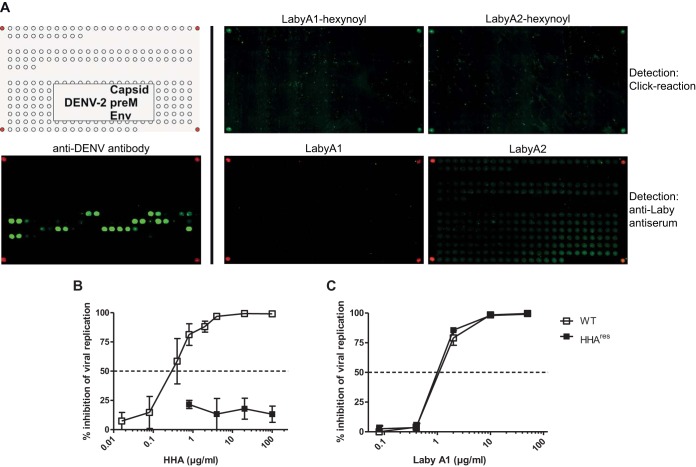FIG 3.
Labyrinthopeptins do not target viral peptides or glycan motifs. (A) Peptide microarrays. The DENV array covered the structural proteins of DENV 2 (E, preM, and C proteins). The top left panel shows the layout of the array, with the corner spots being biotin controls (red). The bottom left panel is the array processed with a polyclonal anti-DENV antibody (PA5-32207; Thermo) directed against the E protein (Env). Several binding epitopes were identified, exemplifying the integrity of this assay. In the upper middle and right panels, arrays were incubated with labyrinthopeptin-hexynoyl derivatives. A biotin moiety was attached using click chemistry, and staining was done afterwards using a Cy3-conjugated anti-biotin antibody. In the lower middle and right panels, arrays were incubated with native LabyA1 or LabyA2 and detection was carried out using the respective anti-LabyA1 or anti-LabyA2 polyclonal antibodies stained with an anti-rabbit Cy3 IgG. (B and C) Antiviral activity of LabyA1 against HHAres DENV-2. Huh-7 cells were infected with WT DENV or with HHAres DENV in the presence of various concentrations of the plant lectin HHA (B) or LabyA1 (C). At 4 days postinfection, the number of DENV-infected cells was quantified by flow cytometry. The mean percentage of inhibition of viral replication ± SEM of up to 4 independent experiments is shown. LabyA1 exhibited equipotent dose-dependent antiviral activities against both WT (IC50: 1.1 μg/ml or 0.53 μM) and HHAres (IC50, 1.0 μg/ml or 0.48 μM) DENV.

